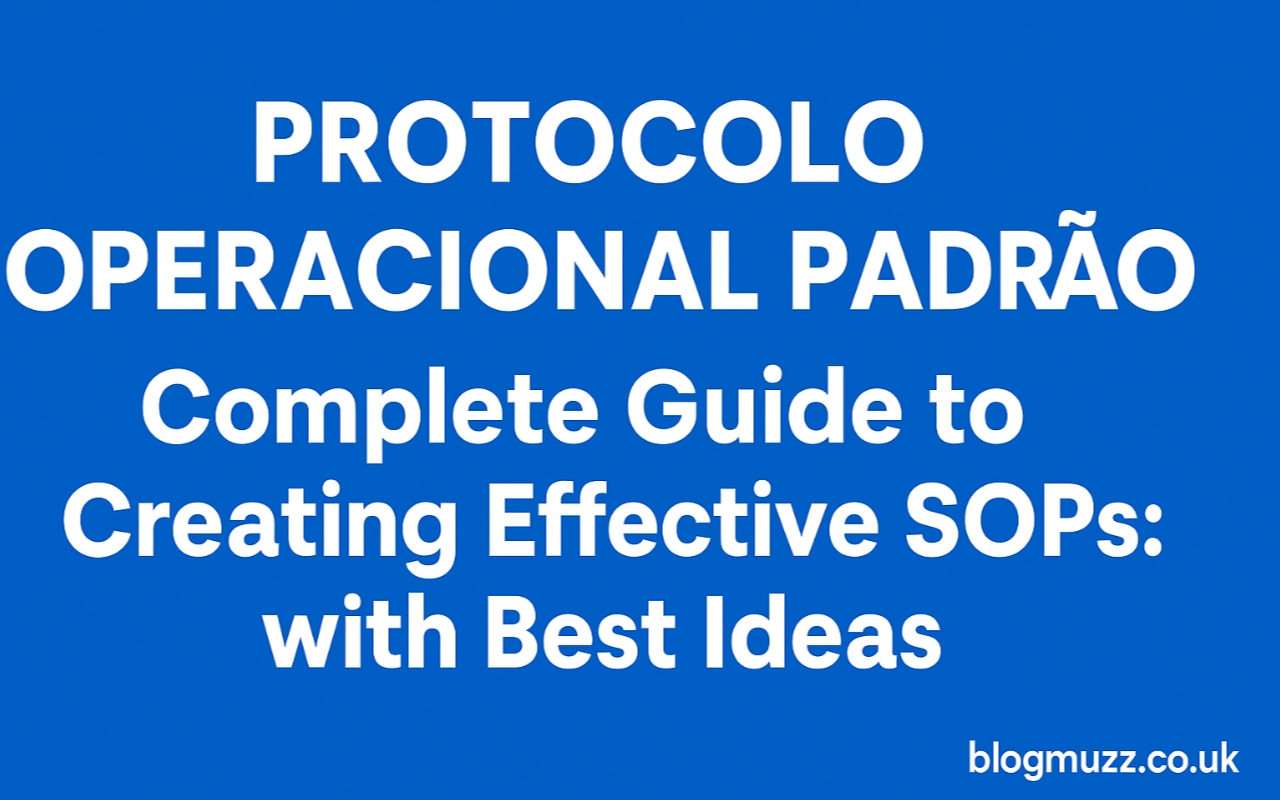Understanding the Concept of Protocolo Operacional Padrao (POP)
The term protocolo operacional padrao, often abbreviated as POP, translates to Standard Operating Procedure (SOP) in English. It represents a written, detailed description of the steps required to carry out specific operations within an organization. The core idea behind a POP is to ensure that every task, no matter who performs it, is executed in a consistent, safe, and efficient manner.
In today’s fast-paced business environment, where quality, safety, and efficiency are essential, having well-structured protocols is no longer optional—it’s a necessity. A protocolo operacional padrao acts as a blueprint for daily activities, allowing teams to reduce human error, maintain compliance, and continuously improve operational standards.
Whether you operate in healthcare, manufacturing, food processing, or administrative services, having a well-defined POP ensures that every team member understands not only what needs to be done but how and why it must be done that way.
The Importance of a Protocolo Operacional Padrao in Modern Organizations
A protocolo operacional padrao is much more than just a document—it’s a tool for organizational excellence. Companies that operate without standard procedures often face problems like inconsistent output, safety risks, communication failures, and non-compliance with regulations. By contrast, organizations that embrace POPs enjoy improved reliability, streamlined training, and better customer satisfaction.
The main benefits of implementing a POP include:
- Consistency in Operations – Every employee follows the same method, ensuring uniform quality and outcomes.
- Regulatory Compliance – Many industries, especially healthcare and manufacturing, require documented procedures to meet legal and quality standards.
- Training Efficiency – POPs act as training guides for new hires, reducing the time and cost associated with onboarding.
- Error Reduction – When employees clearly understand each step, the risk of mistakes is minimized.
- Continuous Improvement – Documented procedures make it easier to identify bottlenecks and optimize workflows.
In essence, the protocolo operacional padrao serves as a backbone for governance, discipline, and accountability within any organization.
Key Elements That Make an Effective Protocolo Operacional Padrao
Creating a protocolo operacional padrao is not simply about writing instructions—it’s about developing a document that is clear, precise, and actionable. Every effective POP should contain the following key elements:
- Title and Identification – Clearly indicate what process the document covers. Include version numbers and revision dates.
- Purpose and Scope – Define why the procedure exists and what areas or departments it applies to.
- Responsibilities – Specify who performs each task and who is responsible for oversight or approval.
- Definitions and Terminology – Clarify technical terms to avoid confusion.
- Required Materials and Equipment – List everything needed to complete the task.
- Step-by-Step Instructions – The heart of the POP. Present each action logically and chronologically.
- Safety and Quality Notes – Identify potential hazards, safety precautions, and quality control checkpoints.
- References and Appendices – Include related policies, diagrams, or checklists.
When these elements are well-structured, the POP becomes an accessible, practical tool rather than a bureaucratic formality.
Step-by-Step Guide to Creating an Effective Protocolo Operacional Padrao
Designing a protocolo operacional padrao that truly improves performance requires a structured approach. Below is a comprehensive guide to creating one from scratch:
1. Analyze the Process
Start by mapping the current workflow. Observe how the task is performed, note variations between employees, and identify critical points that influence quality or safety.
2. Define Objectives
Ask: What outcome should this POP guarantee? Whether it’s standardizing customer service interactions or ensuring safe handling of laboratory materials, clarity of purpose drives relevance.
3. Engage the Team
The best POPs are developed collaboratively. Involve employees who actually perform the tasks—they understand the practical details better than anyone else.
4. Draft the Procedure
Write the steps clearly, using action verbs and simple language. Avoid ambiguity and ensure each step represents a single, measurable action.
5. Test and Validate
Before official approval, test the procedure in real-world conditions. Gather feedback and make adjustments to eliminate confusion or inefficiencies.
6. Obtain Approval
Once validated, submit the POP to relevant managers or compliance officers for authorization. Record the approval date and responsible signatures.
7. Train and Implement
Distribute the new protocol to all affected employees. Conduct training sessions to ensure everyone understands the procedure and can execute it confidently.
8. Monitor and Update
A protocolo operacional padrao should evolve. Review it regularly—at least annually or after any significant operational change—to maintain accuracy and effectiveness.
Common Mistakes to Avoid When Writing a Protocolo Operacional Padrao
Even with the best intentions, many organizations fail to create usable POPs because of avoidable mistakes. The most frequent errors include:
- Overly Complex Language: Using technical jargon makes it difficult for employees to understand or follow instructions.
- Lack of Visual Aids: Diagrams, photos, or flowcharts can make complex procedures easier to follow.
- Ignoring User Feedback: A POP written only by management might not reflect operational realities.
- Failure to Update: Procedures quickly become outdated if not reviewed regularly.
- No Clear Ownership: Without assigning responsibility for maintenance, documents lose credibility.
Avoiding these pitfalls ensures your protocolo operacional padrao remains practical and respected within the organization.
Examples of Protocolo Operacional Padrao Across Different Industries
The concept of POP applies universally but looks different depending on the field. Let’s explore how various sectors implement it:
1. Healthcare
Hospitals use POPs to standardize patient care, medication administration, and sterilization processes. For example, a protocol for “preparing an operating room” might detail every step, from sanitation to equipment setup, ensuring patient safety.
2. Manufacturing
Factories rely on POPs for machine operation, quality control, and safety inspections. A standardized process helps prevent defects and ensures compliance with ISO quality standards.
3. Food and Beverage
Restaurants and food production facilities use POPs for hygiene, cooking, and storage procedures. They are crucial for meeting sanitary regulations and preventing contamination.
4. Laboratories
In scientific environments, POPs define procedures for sample handling, reagent preparation, and data recording—vital for maintaining reproducibility and credibility of results.
5. Administrative and Service Sectors
Even offices benefit from POPs—such as protocols for document management, customer service, or IT support requests—enhancing consistency and professionalism.
These examples illustrate that regardless of the context, a protocolo operacional padrao provides stability and trustworthiness.
How to Train Employees to Follow a Protocolo Operacional Padrao
A well-written POP is useless if employees do not understand or respect it. Training is, therefore, a critical component of successful implementation.
- Conduct Practical Workshops: Instead of just distributing documents, walk employees through the process using demonstrations or simulations.
- Use Checklists and Visual Aids: Visual tools help reinforce learning and reduce cognitive load.
- Evaluate Understanding: Use quizzes, observations, or performance assessments to confirm comprehension.
- Encourage Feedback: Workers often discover better ways to execute certain tasks; encourage open communication for improvement.
- Integrate POPs into Onboarding: Make new hires familiar with core procedures from day one to build discipline and alignment.
Consistent and interactive training ensures that the protocolo operacional padrao becomes part of the company culture rather than a forgotten manual.
Monitoring, Auditing, and Updating Your POP
Implementation is only the beginning. To ensure long-term success, organizations must monitor compliance and audit their POPs regularly.
Auditing involves comparing actual practices with documented procedures. Any deviation can signal either non-compliance or a need to revise the document. Tracking metrics—such as error rates, rework frequency, or customer complaints—can indicate whether the POP is producing the desired results.
Updating should be systematic. Whenever equipment, materials, or regulations change, the POP must be reviewed. Include a revision history table that records who updated the document, when, and why. This transparency builds trust and accountability.
A living, well-maintained protocolo operacional padrao demonstrates organizational maturity and commitment to excellence.
Digital Transformation and the Future of Protocolo Operacional Padrao
Modern organizations are increasingly adopting digital platforms to manage their POPs. Instead of paper manuals stored in binders, cloud-based systems allow employees to access the latest procedures in real time through mobile devices or company intranets.
Benefits of digitized POPs include:
- Instant Updates: New versions can be published instantly across all departments.
- Easy Accessibility: Staff can search and retrieve procedures anytime, anywhere.
- Version Control: Prevents confusion by ensuring everyone uses the current document.
- Integration with Training Systems: Digital POPs can link to e-learning modules, making training seamless.
Artificial intelligence and automation tools are also beginning to assist in POP management. For example, AI can analyze compliance data and suggest procedural optimizations, turning the protocolo operacional padrao into a dynamic performance-enhancement tool.
Challenges in Implementing a Protocolo Operacional Padrao
Despite the clear advantages, implementing POPs comes with certain challenges:
- Resistance to Change: Employees may be hesitant to adopt new ways of working.
- Time and Resource Constraints: Developing comprehensive procedures requires time and collaboration.
- Over-Documentation: Excessive detail can overwhelm users instead of helping them.
- Lack of Leadership Support: Without managerial endorsement, protocols often lose credibility.
To overcome these challenges, leaders must communicate the why behind standardization. Highlighting the benefits—such as fewer errors, better teamwork, and improved safety—encourages acceptance and compliance.
Best Practices for Maintaining Effective SOPs
To ensure long-term effectiveness, organizations should embed the following best practices into their operational culture:
- Keep It Simple: Write in plain language and focus on actionable steps.
- Engage Cross-Functional Teams: Collaboration ensures that the POP reflects real conditions.
- Promote Accountability: Assign owners to maintain and review documents.
- Use Metrics to Measure Impact: Track how POPs influence performance indicators.
- Celebrate Compliance: Recognize departments or individuals that exemplify procedural excellence.
A protocolo operacional padrao thrives in a culture that values precision, learning, and improvement.
Conclusion: Turning Documentation into Excellence
The protocolo operacional padrao is far more than administrative paperwork—it’s a strategic tool that defines how an organization achieves reliability, quality, and continuous improvement. When developed thoughtfully, implemented effectively, and reviewed regularly, a POP becomes a living system that empowers employees, strengthens compliance, and enhances organizational performance.
From healthcare to manufacturing, from small businesses to global enterprises, the principle remains the same: clarity creates consistency, and consistency builds excellence.
Investing time and effort into crafting a robust protocolo operacional padrao will not only streamline operations but also cultivate a culture of discipline, safety, and efficiency that sustains long-term success.



